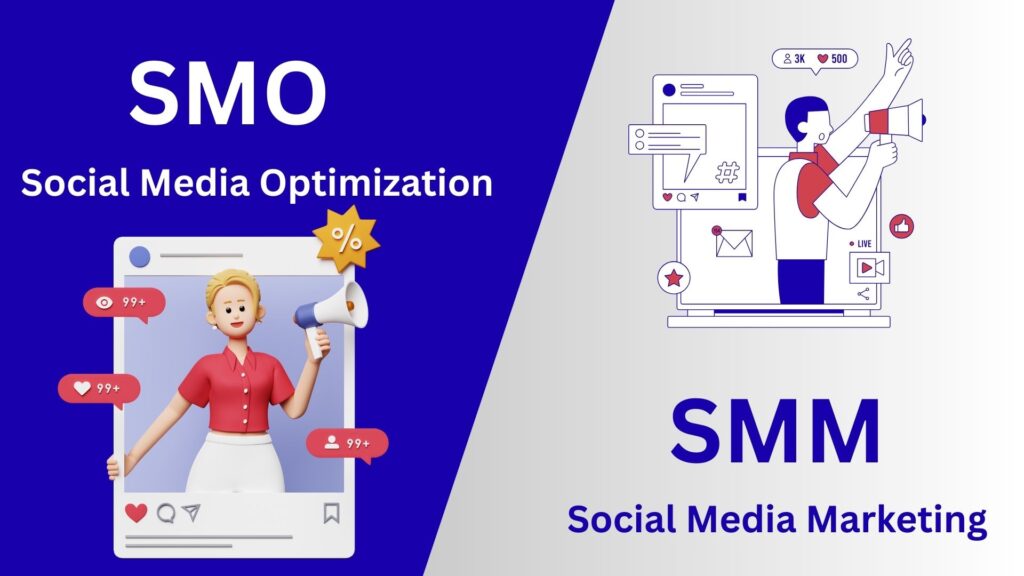If you’ve ever tried to grow your brand online you’ve probably come across terms like SMO and SMM. These two buzzwords confuse beginners in digital marketing but they play a huge role in building visibility, engagement and conversions through social media.
So, what exactly is SMO? And how is it different from SMM? In this blog we’ll break down the concepts, benefits, strategies and differences in a simple way. By the end of this guide you’ll have a clear understanding of how both can power up your social media marketing.
What is SMO?
SMO stands for Social Media Optimization.
It’s the process of optimizing your social media profiles and content to make them more engaging, shareable and visible to your audience. Think of it as SEO for social media. Just like we optimize websites to rank higher on Google we optimize social media pages and posts so they can reach more users and encourage interactions.
Goals of SMO
- Improve brand visibility across platforms
- Boost organic reach without spending heavily on ads
- Create shareable, high-quality content
- Build trust and credibility with audiences
Examples of SMO in action:
- Using the right profile picture, cover photo, and consistent branding
- Writing keyword-rich social media bios
- Adding clickable links and CTAs in your posts
- Posting at the right time for better engagement
- Encouraging social sharing with hashtags and catchy captions
In short, SMO is about making your social pages attractive, discoverable, and engaging to users.
What is SMM?
SMM stands for Social Media Marketing. This is promoting your brand, products, or services on social media through organic and paid methods.
SMO is about optimisation, SMM is about implementation and promotion. It’s about running campaigns, engaging with followers, and driving measurable results like sales, leads or traffic.
Goals of SMM
- Generate more leads and conversions
- Build loyal communities
- Run effective ad campaigns on platforms like Facebook, Instagram, or LinkedIn
- Track analytics to improve performance
Examples of SMM in action:
- Running Facebook or Instagram ads to promote a campaign
- Partnering with influencers to reach larger audiences
- Using TikTok/Reels marketing to showcase creative ads
- Hosting giveaways, contests, or live sessions to interact with followers
SMM is the execution part of social media strategy, where you put in effort and often budget to get business results.
SMO vs SMM: What’s the Difference?
Although people often confuse SMO and SMM, they are two sides of the same coin. Let’s quickly compare:
| Aspect | SMO (Social Media Optimization) | SMM (Social Media Marketing) |
| Definition | Optimizing social profiles & content for better visibility | Promoting products/services through ads & campaigns |
| Focus Area | Organic growth, engagement, and brand presence | Paid ads, promotions, and measurable conversions |
| Goal | Improve discoverability & content quality | Drive traffic, leads, and sales |
| Cost | Mostly free (organic optimization) | Often requires a budget for ads |
| Example | Optimizing bio, using hashtags, posting at peak times | Running a Facebook Ad campaign, hiring influencers |
Why Are SMO and SMM Important for Businesses?
- More eyes on your brand: Through optimized content and ads.
- More conversations: Social media is all about conversations. Done right, SMO and SMM help you build real relationships.
- More website traffic: A CTA on your social pages can bring visitors to your website.
- More leads & sales: Paid ads under SMM can funnel ready-to-buy customers.
- Don’t get left behind: Every business is on social media today. Without optimization and marketing, you’ll get lost.
Best Practices for SMO
- Optimize your profile with consistent branding
- Use target keywords in bios and descriptions
- Post quality content consistently
- Add social sharing buttons on your website/blog
- Use relevant hashtags to improve discoverability
Best Practices for SMM
- Identify your target audience and use relevant platforms
- Run A/B testing for ad campaigns
- Track performance with tools like Facebook Insights or Google Analytics
- Collaborate with influencers in your niche
- Invest in retargeting ads to re-engage potential buyers
Common Mistakes to Avoid
- Posting without a content strategy.
- Spamming hashtags or irrelevant content.
- Ignoring comments and messages from followers.
- Overspending on ads without tracking results.
- Copying competitors instead of building a unique brand voice.
FAQs on SMO and SMM
1. What comes first, SMO or SMM?
Usually, SMO comes first because you need a strong, optimized social presence before running paid campaigns.
2. Can small businesses use SMO and SMM together?
Absolutely. SMO builds trust organically, while SMM boosts reach with ads, making it a powerful combo for small businesses.
3. Do I need a big budget for SMM?
Not necessarily. Even with small budgets, targeted ads can bring great results when used strategically.
4. Is SMO still relevant in 2025?
Yes! With changing algorithms, an optimized profile helps your content rank better and reach more audiences organically.
Conclusion
Now that you know what SMO (Social Media Optimization) and SMM (Social Media Marketing) are, you can see they’re not competitors but partners.
- SMO makes sure your social profiles and content are visible and engaging.
- SMM uses campaigns, ads, and promotions to get targeted results like leads and sales.
Together, they make a powerful digital marketing strategy in today’s business world.
So whether you’re a small business owner, a marketer, or just someone building a personal brand, start with SMO, boost with SMM, and watch your social media grow.

